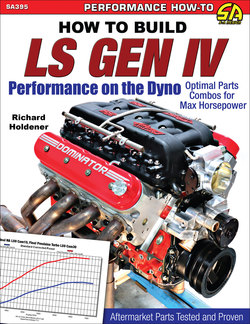Читать книгу How to Build LS Gen IV Performance on the Dyno - Richard Holdener - Страница 5
На сайте Литреса книга снята с продажи.
ОглавлениеABOUT THE AUTHOR
It is hard to believe that all of this dyno madness started with a phone call to then-editor of Turbo magazine, Kipp Kington. Who would have guessed that a simple story about his adventures at the Silver State Open Road race would send Richard Holdener on a completely different career path? Much to the dismay of his parents, the advertising degree was not utilized in some fancy office on Madison avenue. Instead, he decided to follow his passion for all things automotive.
First as a reader then as a writer, Holdener was fascinated by genuine testing. Forget all the advertising (and now Internet) hype about a product; he said “Let’s put it on the dyno and see how she does!” For his first day on staff, he was the guy pushing for dyno testing and acceleration testing the performance potential of products. As you might imagine, this type of verification was met with some resistance from advertisers. According to Holdener, “The readers deserved to know what works and what doesn’t.”
If you want to find Richard Holdener, look no further than on the dyno at Westech Performance. For more than 25 years, he has worked as a technical editor for a wide range of automotive magazines, both on staff and in a freelance capacity. Richard has specialized in direct back-to-back dyno testing of performance products. He is the crazy guy who compared every factory LS cam, 20 different LS intake manifolds, and dyno (and flow) tested no less than 30 different LS cylinder heads. He is also the guy who performed the Big Bang Theory test, where they cranked up the boost on a stock LS short-block to find out how much power it could withstand. He is the reason so many 1,000-hp stock, short-block LS engines exist.
Unfortunately, you can also thank him for the price increase on LS engines from the wrecking yard, as after the results of the Big Bang Theory, guys were swarming the wrecking yards gathering all the LS motors they could to install turbos. Always looking to illustrate what really works, Holdener even went so far as to design his own adjustable intake manifolds for testing (see Chapter X [intake]). Whether it’s blown, built, or boosted, everything from stock LS3 crate engines to 8,000-rpm, short-stroke screamers, Holdener has built and tested it on the dyno.
In addition to this (his 10th) book on LS3 and LS7 Performance, Holdener has also written several other books on dyno verification. These include Dyno-Proven GM LS1 thru LS7 Performance Parts, Building 4.6L/5.4L Ford Horsepower on the Dyno, High-Performance Ford Focus Builder’s Handbook, How To Build Honda Horsepower, and 5.0L Ford Dyno Tests. Holdener currently contributes to all the major automotive magazines, including Hot Rod, Car Craft, Super Chevy, Muscle Mustangs & Fast Fords, Power & Performance News, and GM High Tech.
